Freight from around the world is once again flowing through Canada’s busiest port and buses are once again rolling through one of the most populated parts of B.C.
But the just-concluded strike of B.C. longshore workers and transit workers in the Fraser Valley are also reminders of growing labour strife across North America and it is not clear yet who will come out ahead.
That is the reading of Rob Gillezeau, assistant professor in the Department of Economics at the University of Victoria, as strikes across various sectors, from studios in glitzy Hollywood to gritty shipping docks, continue to make headlines, with more disputes on the horizon.
“If we compare this year to maybe the last decade or the last 15 years, we are definitely seeing a surge in labour militancy,” Gillezeau said.
Consider the Fraser Valley transit worker strike. It lasted some 124 days, falling just days short of the historic Sea-to-Sky transit worker strike, which lasted 136 days.
Shorter, but far more significant, was the strike of some 7,400 longshore workers. Long in the making, this on-and-off dispute lasted just over a month, but required government intervention and could exact heavy cost on the Canadian economy. According to a measure from the BC Chamber of Commerce, it disrupted some $10 billion of cargo since July 1, causing frustrations up and down the supply chain, and raising questions about the reliability of Canada’s place in the fabric of globalization.
On the other hand, these strikes can also be read as necessary correctives to intolerable conditions.
RELATED: New tentative deal is reached in B.C. port workers dispute
Reasons for this summer of labour discontent are the familiar ones: technology threatening to replace workers (actors and screenwriters fearing artificial intelligence, longshore workers fearing automation); but above else, wages.
Inflation, although now falling from double-digit levels at its peak some 18 months ago, has led to a “giant decline” in real purchasing power across all sectors of the economy, Gillezeau said. Declining purchasing power co-exists with a labour market at full capacity, giving workers leverage against their employers, he added.
By definition, labour disputes have consequences. Striking workers forego real pay cheques in the present for the contingent, yet-to-be realized promise of higher ones in the future. Businesses lose customers and revenue streams. Residents have to find alternative products and services, if available.
Gillezeau said the effects of strikes depend on circumstances.
“If we start to see real compensation catching up in some areas, employers are going to feel some pressure (to raise wages),” he said, adding employees can jump to other sectors.
But Gillezeau also pointed to the costs among business owners and individuals inconvenienced by strikes.
RELATED: Transit strike in eastern Fraser Valley could end up costing man his job in Vancouver
These disputes also have a public dimension, which goes beyond the back-and-forth of backroom negotiations, with both sides appealing to the public for support.
Employers and their allies in business organizations have naturally emphasized the negative sides of strikes, including disruptions and higher costs for consumers. Striking workers and their supporters, meanwhile, have highlighted the potential benefits of higher wages and better working conditions for the rest of the economy, including other workers, and ultimately union membership itself.
Gillezeau said the arguments do not surprise him, but he is not sure that higher wages gained through strikes will have the dire consequences some employers predict.
“It depends on the competitiveness of these different sectors, but I think it is extremely unlikely that you will see a full pass-through (of higher wage costs on to customers),” he said.
On the other hand, Gillezeau is also not sure whether the current run of strikes in the face of continuing inflation will serve as a catalyst for the historical revival of the union movement, which has been losing ground since the 1970s.
Support for unions as measured by public union polling in Canada and the United States has been “spiking” since the start of COVID-19, Gillezeau said.
“The desire of individual people in public opinion polling to be in a union is at its highest point in ages,” he said. “When you feel are you getting ripped off, you typically want to do something about it.”
But job actions themselves are something else.
“It depends on the outcome,” he said. “Going on strike is not fun. Going on strike is particularly tough for the workers who are out on the picket line.”
Gillezeau said the “substantial wage increases” seen in the agreement for longshore workers could have an effect, but other factors come into play as well. It is not easy to form unions, because of the needed effort and time, he said. While union membership in Canada is much higher than in the United States, union organizing is less robust, Gillezeau said.
Ultimately, the final outcome of these disputes remains outstanding.
“Real wages have fallen by so much for so many workers that … it would be depressing and difficult to imagine a world in which we don’t see these wins result in some compensation catch-up,” Gillezeau said, adding that it would take “a lot of big wins to have meaningful catch-up.”
Bargaining power right now lies with labour, he said. “But that being said, it doesn’t take so many things to change. Let’s imagine some type of additional economic shock and we end up in recession. Overnight, that bargaining power could change.”
@wolfgangdepner
wolfgang.depner@blackpress.ca
Like us on Facebook and follow us on Twitter.

